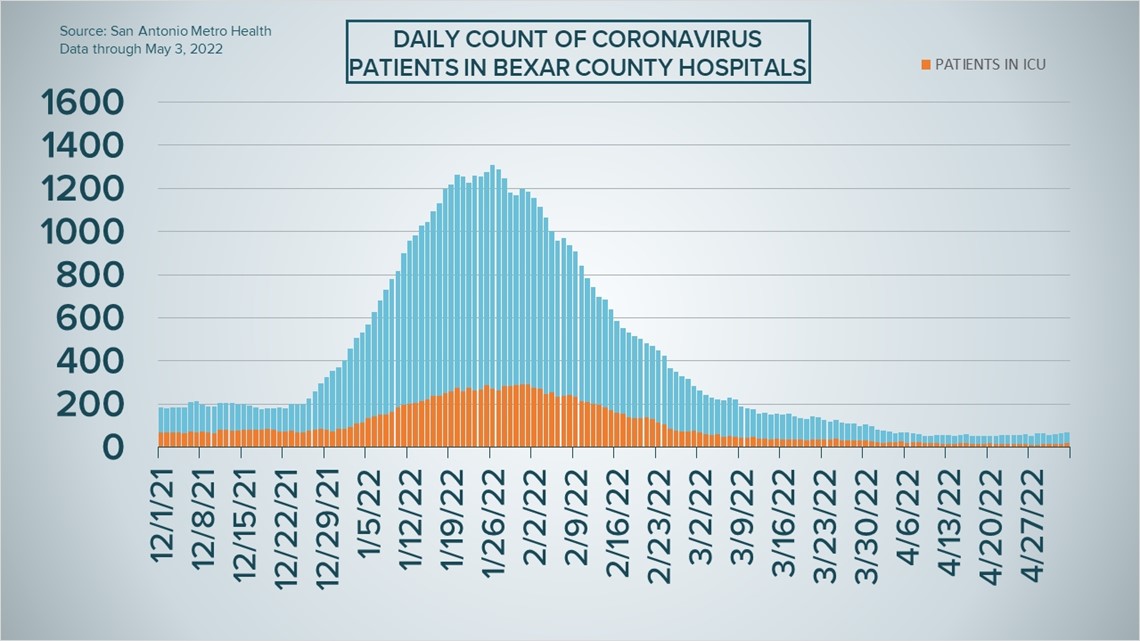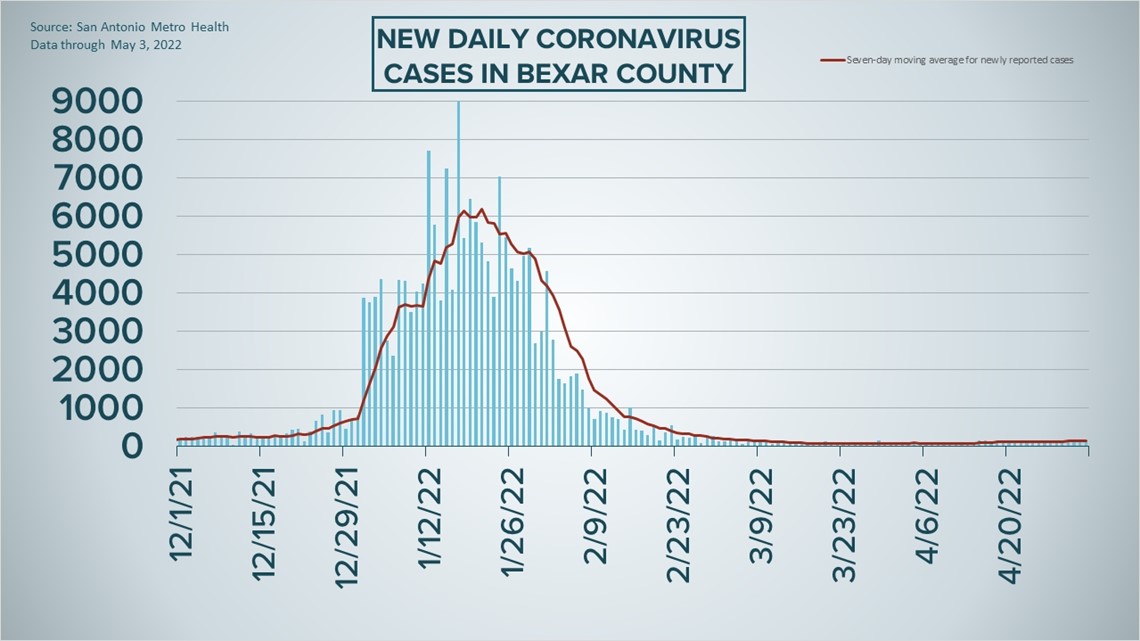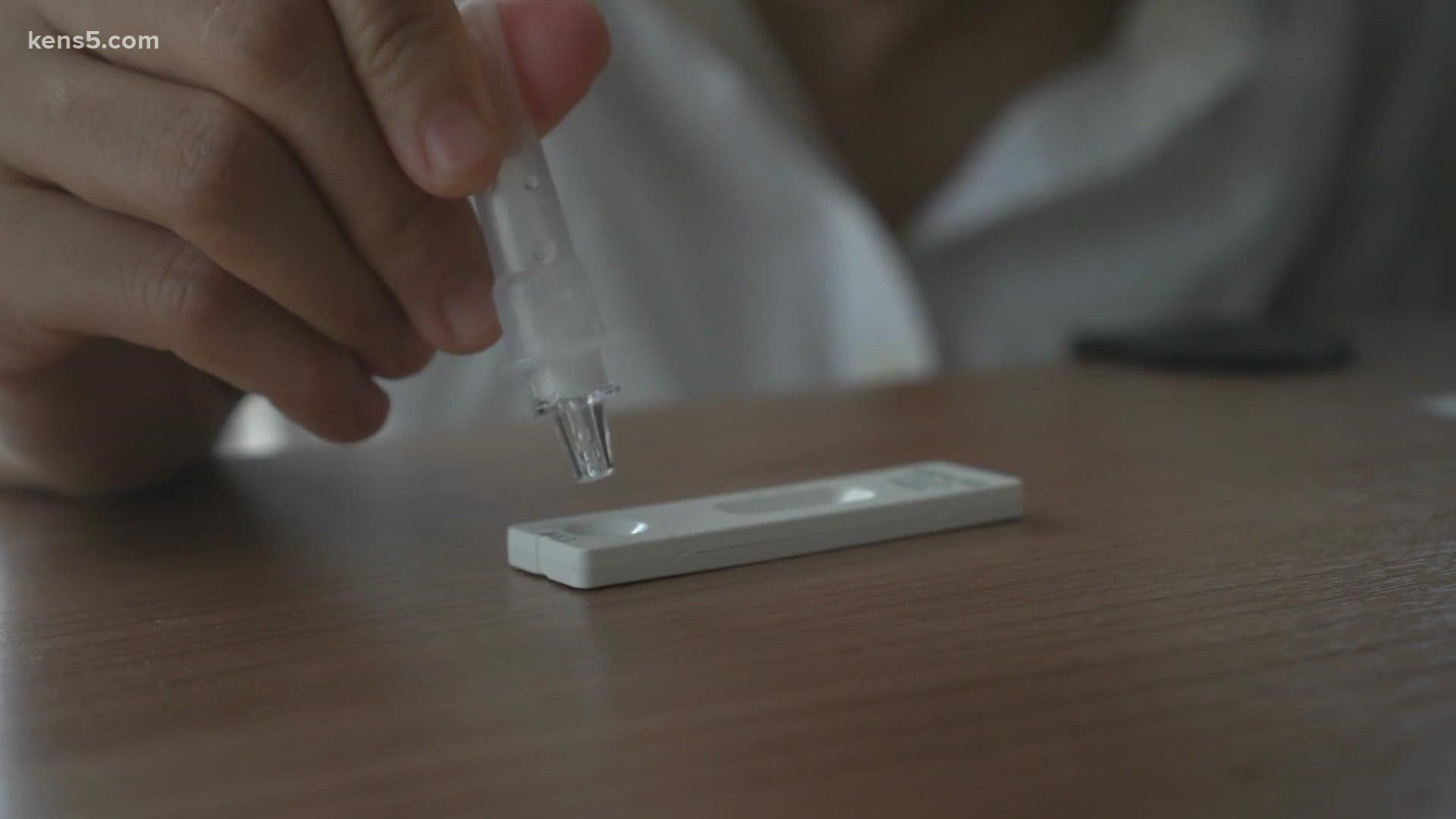SAN ANTONIO — A week after San Antonio-area health officials raised the COVID-19 risk indicator to the "mild" threshold, they returned the meter back to the lowest level on Tuesday—a day which saw Metro Health record fewer than 100 new infections for the first time in a week.
The new risk level meter includes three tiers of Low, Medium and High, compared to the previous five-threshold level that was in place since Metro Health began closely monitoring the coronavirus situation over two years ago.
Dr. Anita Kurian, assistant Metro Health director, said in a statement that as the community moves from a COVID-control response to a COVID-management response, "it will remain important to monitor severe illnesses using hospitalization data."
She added her team would continue to keep an eye on new-case rates, mirroring the Centers for Disease Control's model, while also observing the rate of new coronavirus-related hospital admissions. The Bexar County COVID-19 Community Level will be determined "by looking at hospital beds being used, hospital admission and the total numbers of new COVID-19 cases in an area."
While local hospitalizations have steadily increased over the last two weeks – from 51 on April 19 to 67 on Tuesday – the uptick has been miniscule compared to numbers seen earlier this year, especially amid January's omicron-fueled surge. Of those 67 patients being treated Tuesday, 20 were in intensive care and 10 were using ventilators.
Ninety-one additional COVID-19 cases were reported Tuesday, a lower number that kept the seven-day case average at 127 for a second consecutive day. No new virus-related deaths have been reported in nearly two weeks.
How Bexar County is trending




Vaccine Progress in Bexar County
The following numbers are provided by San Antonio Metro Health. A full breakdown can be found here.
- 1.445 million eligible Bexar County residents are fully vaccinated as of Monday, April 25.
- More than 509,000 eligible Bexar County residents have received their COVID-19 booster shot, as of Monday, April 25.
The CDC states that "when a high percentage of the community is immune to a disease (through vaccination and/or prior illness)," that community will have reached herd immunity, "making the spread of this disease from person to person unlikely."
The City of San Antonio breaks down the vaccination rates by zip code on Metro Health's Vaccination Statistics page.
Coronavirus in Texas
The total number of coronavirus cases in the state since the pandemic began grew by 2,202 on Tuesday, according to the Texas Department of State Health Services. That total includes 1,420 new confirmed cases and 782 new probable cases. More details can be found on this page.
Tuesday's figures bring the total number of Texans diagnosed with COVID-19 to more than 6.746 million.
An additional 12 Texans have died from virus complications, meanwhile, raising the statewide death toll to 86,579.
Coronavirus symptoms
The symptoms of coronavirus can be similar to the flu or a bad cold. Symptoms include fever or chills, cough, shortness of breath or difficulty breathing, fatigue, muscle or body aches, headache, new loss of taste or smell sore throat, congestion or runny nose, nausea or vomiting, and diarrhea, according to the Centers for Disease Control.
Most healthy people will have mild symptoms. A study of more than 72,000 patients by the Centers for Disease Control in China showed 80 percent of the cases there were mild.
But infections can cause pneumonia, severe acute respiratory syndrome, kidney failure, and even death, according to the World Health Organization. Older people with underlying health conditions are most at risk.
Experts determined there was consistent evidence these conditions increase a person's risk, regardless of age:
- Chronic kidney disease
- COPD (chronic obstructive pulmonary disease)
- Obesity (BMI of 30 or higher)
- Immunocompromised state (weakened immune system) from solid organ transplant
- Serious heart conditions, such as heart failure, coronary artery disease, or cardiomyopathies
- Sickle cell disease
- Type 2 diabetes
- The CDC believes symptoms may appear anywhere from two to 14 days after being exposed.
Human coronaviruses are usually spread...
- Between people who are in close contact with one another (within about 6 feet).
- Through respiratory droplets produced when an infected person coughs, sneezes or talks. These droplets can land in the mouths or noses of people who are nearby or possibly be inhaled into the lungs.
- Some recent studies have suggested that COVID-19 may be spread by people who are not showing symptoms.
Help stop the spread of coronavirus
- Stay home when you are sick.
- Eat and sleep separately from your family members
- Use different utensils and dishes
- Cover your cough or sneeze with your arm, not your hand.
- If you use a tissue, throw it in the trash.
Find a Testing Location
City officials recommend getting a COVID-19 test if you experience fever or chills, cough, shortness of breath or difficulty breathing, fatigue, muscle or body aches, headache, new loss of taste or smell, sore throat, congestion or runny nose, nausea or vomiting, or diarrhea.
Here's a Testing Sites Locator to help you find the testing location closest to you in San Antonio.
Latest Coronavirus Headlines
- Should you still wear a mask on planes, trains? What CDC says now.
- Verify: Yes, you should not use an at-home coronavirus test kit past its expiration date
- When is it time for your second booster?
- Moderna aims for greenlight of latest COVID vaccine, designed for kids 6 months to 5 years old
- New CDC report estimates percentage of Americans with COVID antibodies
- Fauci says US entering transitionary phase of COVID pandemic
- Administration expands availability of COVID antiviral pill

